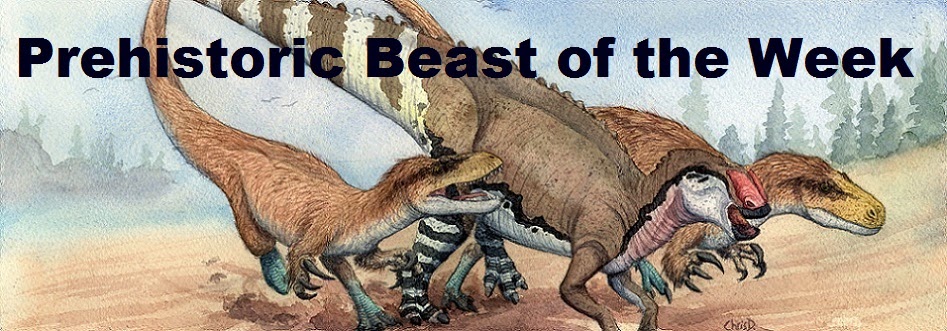This week we will be checking out an early dinosaur that helps us understand the dinosaur family tree as a whole. Let's check out Unaysaurus tolentinoi!
.jpg) |
| Watercolor reconstruction of Unaysaurus by Christopher DiPiazza. |
Unaysaurus was a plant-eating, possibly omnivorous, dinosaur that lived in what is now Brazil, during the late Triassic period, about 225.4 million years ago. From nose to tail it measured about 8 feet (2.5 meters) long. It's name translates to "black water reptile" from the Tupi language, from near where it was discovered. This is in reference to the region in which its fossils were found, which is called "Agua Negra" (black water) in Portuguese.
Unaysaurus is was a member of what is referred to as the prosauropod group of dinosaurs. Like their generally larger relatives, the sauropods, like Brachiosaurus and Apatosaurus, they possessed long necks and proportionally small heads, but differed in that they often could walk on their hind legs, some of which were actually obligatory bipeds, able to walk on their hind legs only. It is thought by most experts that the true sauropods evolved from a branch of prosauropods somewhere during the early Jurassic or possibly even the late Triassic period. Unaysaurus was a particularly small member of the prosauropod group, with other members, like Plateosaurus and Ingentia growing to be quite large in comparison. What makes Unaysaurus stand out the most, however, is the fact that was especially old for its lineage, predating most other prosauropods by millions of years. It is considered one of the oldest sauropodomorphs ever discovered alongside its close relative, Macrcocollum.
 |
| Diagram and photograph of Unaysaurus' skull in the paper by Leal et al. referenced below. |
Unaysaurus is known from surprisingly a complete skeleton, including an almost complete skull with teeth, arm bones, vertebra, and some leg bones, so we have a decent idea of what it looked like. Like most prosauropods it had a long, almost rectangular skull, with a slightly downturned lower jaw, which possessed small leaf-shaped teeth. It likely was primarily a plant-eater but it very well could have eaten smaller animals, as well, like invertebrates or possibly tiny reptiles. It had proportionally short arms so it was likely an obligatory biped, only able to walk on its hind legs. Because of its small size and relatively light build, it may have relied on speed or possibly camouflage to avoid predators.
References
Buffetaut, E.; Suteethorn, V.; Cuny, G.; Tong, H.; Le Loeuff, J.; Khansubha, S.; Jongautchariyakul, S. (2000). "The earliest known sauropod dinosaur". Nature. 407 (6800): 72–74.
Leal, L.A.; Azevodo, S.A.K.; Kellner, A.A.W.; da Rosa, A.A.S. (2004). "A new early dinosaur (Sauropodomorpha) from the Caturrita Formation (Late Triassic), Paraná Basin, Brazil". Zootaxa. 690: 1–24.
Soares, M.B.; Schultz, C.L.; Horn, B.L.D. (2011). "New information on Riograndia guaibensis Bonaparte, Ferigolo & Ribeiro, 2001 (Eucynodontia, Tritheledontidae) from the Late Triassic of southern Brazil: anatomical and biostratigraphic implications". Anais da Academia Brasileira de Ciências. 83 (1): 329–354.
Rauhut, O. W. M.; Holwerda, F. M.; Furrer, H. (2020). "A derived sauropodiform dinosaur and other sauropodomorph material from the Late Triassic of Canton Schaffhausen, Switzerland". Swiss Journal of Geosciences.
Rodrigo Temp Müller; Max Cardoso Langer; Sérgio Dias-da-Silva (2018). "An exceptionally preserved association of complete dinosaur skeletons reveals the oldest long-necked sauropodomorphs". Biology Letters. 14 (11): 20180633.

No comments:
Post a Comment